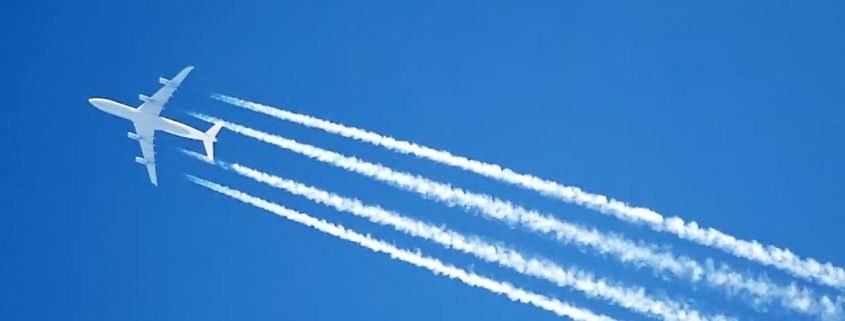Plane contrails have been found to increase heat in the upper atmosphere.
When an aircraft passes by overhead, it sometimes leaves a trail. These white lines of cloud, marking the path of the flight, are known as contrails. But why do they leave them, what are they made of, and are they always the same? Let’s take a look.
What are contrails?
Contrails are literally tiny clouds. They are formed from water vapor which freezes around small particles from the aircraft exhaust. Some of the water vapor is from the air itself, whilst some comes from the aircraft’s own exhaust. Much like a car might make a little white cloud near its exhaust on a cold morning, a plane will often leave a trail if the conditions are right.
Exhaust from jet engines is pretty much all water vapor, although there can be trace content of sulfur oxides, carbon dioxide, nitrogen, unburnt fuel, soot and small particles of metal. These aerosols provide condensation sites for water vapor, as do any small particles in the air it is flying through.
Types of contrails
Although contrails are all made of the same things and created in the same manner, observant skywatchers will know that they don’t always behave the same. Some aircraft leave long, defined contrails that persist for several hours after the plane has passed; others leave very short trails that disappear fast. Why is this?
Well, it’s all to do with the air that the aircraft is passing through. Contrails are generally categorized into three groups; short-lived, persistent (non-spreading) and persistent (spreading).
- Short-lived: These contrails are the smallest ones in the sky. They often look like a short white line following the aircraft’s path, like the tail of a comet. However, they often disappear almost as fast as the plane moves, often lasting no more than a few minutes. This is due to the plane passing through relatively dry air, with only a small amount of water content. As such, the ice that is formed soon becomes vapor again, and the contrail vanishes.
- Persistent contrails (non-spreading): These are the long white lines that often crisscross the skies on a sunny day. They can remain for many hours after the aircraft has passed by, and generally stay fairly defined for some time. This means the plane is passing through very humid air, with lots of water vapor around.
- Persistent contrails (spreading): Contrails that persist but don’t stay in a defined form, rather billow out into fuzzy lines, are known as spreading. These are the contrails that are of most concern to environmentalists, as they create man-made clouds that cover a wider area and are thought to be contributing to climate change.
What planes don’t leave a contrail?
Sometimes, even in the same patch of sky, one plane will leave a trail and one will not. Why is this?
Planes with hotter engines are less likely to form contrails, as the heat of the exhaust prevents ice from forming. Modern planes with more efficient engines burn hotter, but use bypass air to cool the exhaust, making them more likely to leave contrails in a wider range of situations.
However, the simplest reason for whether a plane makes a contrail or not is down to the environment in which it is flying. When the plane is in wet air, it makes a contrail, when it’s not, it doesn’t. It’s really as simple as that.
You might wonder why you’re seeing two planes in the sky at the same time and one is leaving a long trail while the other is not. That’s because the planes are at different altitudes. One is flying in moist air, while the other is flying in drier conditions.
What else do you know about contrails? What else do you want to know? Let us know in the comments!




